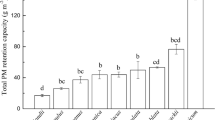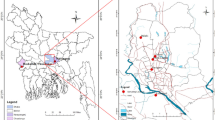Abstract
Plants act as natural scrubbers of urban air particulate matter. However, chemical fractionation of leaf-deposited particulate matter is an unexplored research area demanding immediate attention to get an insight into the source and fate of elements in plants. Therefore, work was carried out to evaluate the spatial and species variability in capturing air particles with variable elemental chemical fractions in an urban area in India. The results favor a distinct spatial and species variability in trapping total and fractional elemental leaf-deposited particulate matter (p < 0.05). Spatially, sensitive (0.135–16.979 μg/cm2) and industrial zones (0.043–3.982 μg/cm2) had a significant impact on the elemental fractionation of particles with the highest inter-species variation. Similarly, Mangifera indica was the best performer in trapping elements of all chemical fractions and was in the order M. indica > Butea monosperma > Ficus benghalensis. Ca and Na were found to be in all chemical fractions. When evaluated for biochemical impact, the leaf-extract pH and relative water content did not show any significant role in regulating the chemical fractionation in leaf deposits. Scanning electron micrographs highlighted the role of the waxy layer and pubescens as efficient particle retention zones. Thus, it is concluded that the chemical fractionation of elements in leaf-deposited particulate matter depends on the category of area and type of plant species.






Similar content being viewed by others
Data availability
All data associated with this study is available with the corresponding author.
References
Abhijith KV, Kumar P (2020) Quantifying particulate matter reduction and their deposition on the leaves of green infrastructure. Environ Pollut 265:114884
Alam RM, West M, Tran TKA, Stein TJ, Gaston TF, Schreider MJ, Reid DJ, MacFarlane GR (2022) Metal(loid) accumulation in the leaves of the grey mangrove (Avicennia marina): assessment of robust sampling requirements and potential use as a bioindicator. Environ Res 211:113065
Alves CA, Barbosa C, Rocha S, Calvo A, Nunes T, Cerqueira M, Pio C, Karanasiou A, Querol X (2015) Elements and polycyclic aromatic hydrocarbons in exhaust particles emitted by light-duty vehicles. Environ Sci Pollut Res 22:11526–11542
Barjoee SS, Malverdi E, Kouhkan M, Alipourfard I, Rouhani A, Farokhi H, Khaledi A (2023) Health assessment of industrial ecosystems of Isfahan (Iran) using phytomonitoring: chemometric, micromorphology, phytoremediation, air pollution tolerance and anticipated performance indices. Urban Clim 48:101394
Bermudez MCR, Gulenc IT, Cameron RW, Inkson BJ (2021) Green barriers for air pollutant capture: leaf micromorphology as a mechanism to explain plants capacity to capture particulate matter. Environ Pollut 288:117809
Cai J, Zhao Y, Kan J, Chen R, Martin R, van Donkelaar A, Ao J, Zhang J, Kan H, Hua J (2020) Prenatal exposure to specific PM2.5 chemical constituents and preterm birth in China: a nationwide cohort study. Environ Sci Technol 54:14494–14501
Cao Z, Zhou X, Ma Y, Wang L, Wu R, Chen B, Wang W (2017) The concentrations, formations, relationships and modeling of sulfate, nitrate and ammonium (SNA) aerosols over China. Aerosol Air Qual Res 17:84–97
Cheng Y, Wang Y, Wang Y, Zhang H, Liang D (2016) Particulate matter adsorption and the main influencing factors of five typical plants in Beijing. Environ Chem 35:1690–1697
Chiang HL, Lai YM, Chang SY (2012) Pollutant constituents of exhaust emitted from light-duty diesel vehicles. Atmos Environ 47:399–406
Dang N, Zhang H, Salam MMA, Li H, Chen G (2022) Foliar dust particle retention and metal accumulation of five garden tree species in Hangzhou: seasonal changes. Environ Pollut 306:119472
Dash PK, Sahu C, Basti S, Sahu SK (2023) Altitude governs the air pollution tolerance and heavy metal accumulation in plants. Environ Monit Assess 195:1122
Dzierzanowski K, Popek R, Gawronska H, Saebo A, Gawronski SW (2011) Deposition of particulate matter of different size fractions on leaf surfaces and in waxes of urban forest species. Int J Phytoremediation 13(10):1037–1046
He C, Qiu K, Pott R (2020) Reduction of urban traffic–related particulate matter—leaf trait matters. Environ Sci Pollut Res 27:5825–5844
Freer-Smith PH, Beckett KP, Taylor G (2005) Deposition velocities to Sorbus aria, Acer campestre, Populus deltoides × trichocarpa ‘Beaupré’, Pinus nigra and × Cupressocyparis leylandii for coarse, fine and ultra-fine particles in the urban environment. Environ Pollut 133:157–167
Gadh R, Singh OV, Tandon SN, Mathur RP (1991) Determination of different soluble species in Yamuna river waters. Environ Technol 12(4):363–369
Gardini EA, Hernandez COA, Baligar VC, He ZL (2017) Heavy metal accumulation in leaves and beans of cacao (Theobroma cacao L.) in major cacao growing regions in Peru. Sci Total Environ 605-606:792–800
Gupta A. 2016. Effect of air pollutants on plant gaseous exchange process: effect on stomata and respiration. In: U. Kulshrestha and P. Saxena (Eds.), Plant responses to air pollution. 3, 85-92.
Hofman J, Stokkaer I, Snauwaert L, Samson R (2013) Spatial distribution assessment of particulate matter in an urban street canyon using biomagnetic leaf monitoring of tree crown deposited particles. Environ Pollut 183:123–132
Hwang H, Yook S, Ahn K (2011) Experimental investigation of submicron and ultrafine soot particle removal by tree leaves. Atmos Environ 45:6987–6994
Kaur M, Nagpal AK (2017) Evaluation of air pollution tolerance index and anticipated performance index of plants and their application in development of green space along the urban areas. Environ Sci Pollut Res 24:18881–18895
Kumar R, Rani M, Gupta H, Gupta B (2014) Trace metal fractionation in water and sediments of an urban river stretch. Chem Speciat Bioavailab 26(4):200–209
Lee JK, Kim DY, Park SH, Woo SY, Nie H, Kim SH (2022) Particulate matter (PM) adsorption and leaf characteristics of ornamental sweet potato (Ipomoea batatas L.) cultivars and two common indoor plants (Hedera helix L. and Epipremnum aureum Lindl. & Andre). Horticulturae 8:26
Leng X, Qian X, Yang M, Wang C, Li H, Wang J (2018) Leaf magnetic properties as a method for predicting heavy metal concentrations in PM2.5 using support vector machine: a case study in Nanjing, China. Environ Pollut 242:922–930
Li C, Du D, Gan Y, Ji S, Wang L, Chang M, Liu J (2022) Foliar dust as a reliable environmental monitor of heavy metal pollution in comparison to plant leaves and soil in urban areas. Chemosphere 287:132341
Liu JX (2015) Study on dust retention ability of six kinds of common vertical green plants. Sichuan Agricultural University (in Chinese)
Mo L, Ma Z, Xu Y, Sun F, Lun X, Liu X, Chen J, Yu X (2015) Assessing the capacity of plant species to accumulate particulate matter in Beijing, China. Plus One 10(10):e0140664
Nadgorska-Socha A, Kandziora-Ciupa M, Trzesicki M, Barczyk G (2017) Air pollution tolerance index and heavy metal bio-accumulation in selected plant species from urban biotopes. Chemosphere 183:471–482
Panda SS, Sahu C, Basti S, Sahu SK (2023) Particle and heavy metal accumulation by two plant species in a coal mining area of Odisha, India. Int J Phytoremediat. https://doi.org/10.1080/15226514.2023.2270613
Prusty BAK, Mishra PC, Azeez PA (2005) Dust accumulation and leaf content in vegetation near the national highway at Sambalpur, Orissa, India. Ecotoxicol Environ Saf 60:228–235
Przybysz A, Saebo A, Hansli HM, Gawronski S (2014) Accumulation of particulate matter and trace elements on vegetation as affected by pollution level, rainfall and the passage of time. Sci Total Environ 481:360–369
Saebo A, Popek R, Nawrot B, Hanslin HM, Gawronska H, Gawronski SW (2012) Plant species differences in particulate matter accumulation on leaf surfaces. Sci Total Environ 427–428, 347– 354
Sahu C, Basti S, Sahu SK (2020) Air pollution tolerance index (APTI) and expected performance index (EPI) of trees in Sambalpur town of India. SN Applied Sciences 2:1327
Sahu C, Basti S, Sahu SK (2021) Particulate collection potential of trees as a means to improve the air quality in urban areas in India. Environ Process 8:377–395
Sgrigna G, Saebo A, Gawronski S, Popek R, Calfapietra C (2015) Particulate matter deposition in Quercus ilex leaves in an industrial city of central Italy. Environ Pollut 197:187–194
Shabnam N, Oh J, Park S, Kim H (2021) Impact of particulate matter on primary leaves of Vigna radiata (L) R Wilczek. Ecotoxicol Environ Safety 212:111965
Shao F, Dong L, Sun F, Wang L, Yu L, Bao Z, Zeng X, Yan H, Wang Y, Li G (2018) Study on different particulate matter retention capacities of the leaf surfaces of eight common garden plants in Hangzhou. China Sci Total Environ 652:939–951
Simon E, Baranyai E, Braun M, Cserhati C, Fabian I, Tothmeresz B (2014) Elemental concentrations in deposited dust on leaves along an urbanization gradiant. Sci Total Environ 490:514–520
Song Y, Mahar BA, Li F, Wang X, Sun X, Zhang H (2015) Particulate matter deposited on leaf of five evergreen species in Beijing, China: Source identification and size distribution. Atmos Environ 105:53– 60
Sun Y, Zhuang G, Wang Y, Han L, Guo J, Dan M, Zhang W, Wang Z, Hao Z (2004) The air-borne particulate pollution in Beijing—concentration, composition, distribution and sources. Atmos Environ 38:5991–6004
Tomson M, Kumar P, Barwise Y, Perez P, Forehead H, French K, Morawska L, Watts JF (2021) Green infrastructure for air quality improvement in street canyons. Environ Int 146:106288
Uka UN, Belford EJD, Hogarh JN (2019) Roadside air pollution in a tropical city: physiological and biochemical response from trees. Bull Natl Res Centre 43:1–12
Vlasov D, Vasil’chuk J, Kosheleva N, Kasimov N (2020) Dissolved and suspended forms of metals and metalloids in snow cover of megacity: partitioning and deposition rates in Western Moscow. Atmosphere 11:907
Wang L, Gao S, Liu L, Ha S (2006) Atmospheric particle-retaining capability of eleven garden plant species in Beijing. J Appl Ecol 17:597–601
Wang Y, Zhuang G, Tang A, Yuan H, Sun Y, Chen S, Zheng A (2005) The ion chemistry and the source of PM2.5 aerosol in Beijing. Atmos Environ 39:3771–3784
Xie J, Jin L, Cui J, Luo X, Li J, Zhang G, Li X (2020) Health risk-oriented source apportionment of PM2.5-associated trace metals. Environ Pollut 262:114655
Xu Y, Xu W, Mo L, Heal MR, Xu X, Yu X (2018) Quantifying particulate matter accumulated on leaves by 17 species of urban trees in Beijing, China. Environ Sci Pollut Res 25:12545–12556
Zhao Z, Luo X, Jing Y, Li H, Pang Y, Wu L, Chen Q, Jin L (2020) In vitro assessments of bioaccessibility and bioavailability of PM2.5 trace metals in respiratory and digestive systems and their oxidative potential. J Hazard Mater 409:124638
Author information
Authors and Affiliations
Contributions
Chandan Sahu and Sradhanjali Basti conceptualized and designed the problem. Material preparation, data collection, and analysis were performed by Sai Pooja Mohanty, Rajesh Mishra, and Sradhanjali Basti. Chandan Sahu supervised the work. The first draft of the manuscript was prepared by Chandan Sahu and all other authors approved the same.
Corresponding author
Ethics declarations
Ethical approval
Not applicable
Consent to participate
Informed consent was obtained from all individual participants in this study.
Consent for publication
The authors grant their consent to publish this manuscript.
Conflict of interest
The authors declare no competing interests.
Additional information
Publisher’s note
Springer Nature remains neutral with regard to jurisdictional claims in published maps and institutional affiliations.
Rights and permissions
Springer Nature or its licensor (e.g. a society or other partner) holds exclusive rights to this article under a publishing agreement with the author(s) or other rightsholder(s); author self-archiving of the accepted manuscript version of this article is solely governed by the terms of such publishing agreement and applicable law.
About this article
Cite this article
Mohanty, S.P., Mishra, R., Basti, S. et al. Chemical fractionation of elements in leaf-deposited particulate matter of an urban area in India. Air Qual Atmos Health (2024). https://doi.org/10.1007/s11869-024-01523-4
Received:
Accepted:
Published:
DOI: https://doi.org/10.1007/s11869-024-01523-4




